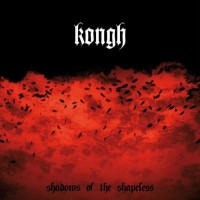Swedish sludge metal trio Kongh finally saw their sophomore album, Shadows of the Shapeless, get an American release date via Seventh Rule Recordings. Finally, us Yanks can hear what those infernal Europeans have been bumping for about a year now. Looks like we've been missing out.
Distinguishing between tracks is kind of pointless with an album like Shadows. The band has three modes: ambient texture, slow ân' sludgy and metal as heck. They segue from one to the next effortlessly or jarringly, whichever feels better in the moment. Sometimes they get bluesy just because they can, like around the one-minute mark of "Essence Asunder." While the band never gets so flashy as to sound pretentious, listeners can tell these guys know what they're doing.
As far as 11-minute openers go, "Unholy Water" is as good a track as any to introduce the album. The band slowly wills the song along, first with some haunting licks. Then the distortion kicks in, menacing in its brevity. The drums start to build up about a minute in. Vocalist David Johansson starts throwing in some of those guitar squealies that metalheads love so much. Two minutes in, the band starts rocking, but they're still not even into the heart of the song yet. It's somewhat laborious to describe; "Unholy Water" gradually morphs from one phase to the next, though such that it doesn't feel nearly as long as one's stereo might indicate.
These strengths double as the band's biggest weaknesses. Shadows certainly shreds in places, but the wait for those passages might be too much for some. This is not the sort of album that pummels relentlessly. There are breaks between beatings. Pastries are served. Others might be turned off by Johansson's vocals. He's a pitch or two higher than your average Cookie Monster, but he's still got that incomprehensible demonic shouting thing going on. That's part of the record's charm, though. It doesn't adhere too strongly to any given sound and proves that the distance between the three styles exhibited here isn't as great as some may think.
